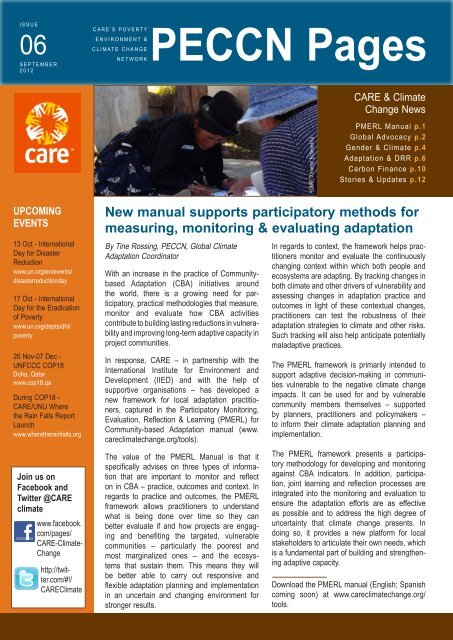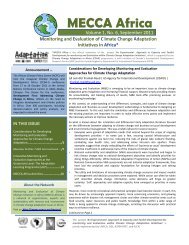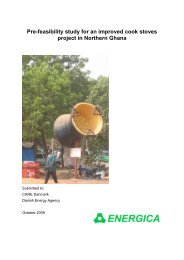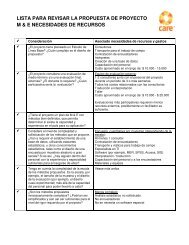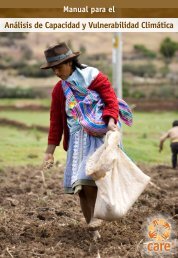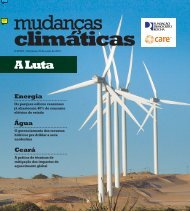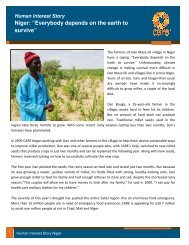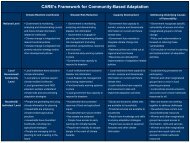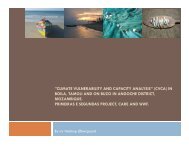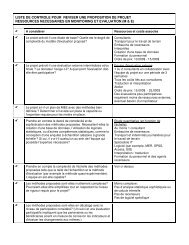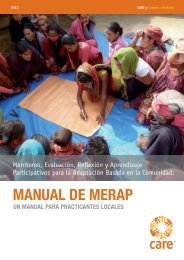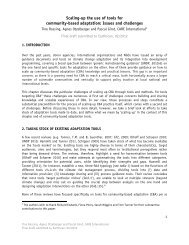PECCN Pages newsletter - CARE Climate Change
PECCN Pages newsletter - CARE Climate Change
PECCN Pages newsletter - CARE Climate Change
You also want an ePaper? Increase the reach of your titles
YUMPU automatically turns print PDFs into web optimized ePapers that Google loves.
ISSUE<br />
06<br />
SEPTEMBER<br />
2012<br />
<strong>CARE</strong>’S POVERTY<br />
<strong>PECCN</strong> <strong>Pages</strong><br />
ENVIRONMENT &<br />
CLIMATE CHANGE<br />
NETWORK<br />
<strong>CARE</strong> & <strong>Climate</strong><br />
<strong>Change</strong> News<br />
©<strong>CARE</strong>/Ximena Echeverria<br />
PMERL Manual p.1<br />
Global Advocacy p.2<br />
Gender & <strong>Climate</strong> p.4<br />
Adaptation & DRR p.6<br />
Carbon Finance p.10<br />
Stories & Updates p.12<br />
UPCOMING<br />
EVENTS<br />
13 Oct - International<br />
Day for Disaster<br />
Reduction<br />
www.un.org/en/events/<br />
disasterreductionday<br />
17 Oct - International<br />
Day for the Eradication<br />
of Poverty<br />
www.un.org/depts/dhl/<br />
poverty<br />
26 Nov-07 Dec -<br />
UNFCCC COP18<br />
Doha, Qatar<br />
www.cop18.qa<br />
During COP18 -<br />
<strong>CARE</strong>/UNU Where<br />
the Rain Falls Report<br />
Launch<br />
www.wheretherainfalls.org<br />
New manual supports participatory methods for<br />
measuring, monitoring & evaluating adaptation<br />
By Tine Rossing, <strong>PECCN</strong>, Global <strong>Climate</strong><br />
Adaptation Coordinator<br />
With an increase in the practice of Communitybased<br />
Adaptation (CBA) initiatives around<br />
the world, there is a growing need for participatory,<br />
practical methodologies that measure,<br />
monitor and evaluate how CBA activities<br />
contribute to building lasting reductions in vulnerability<br />
and improving long-term adaptive capacity in<br />
project communities.<br />
In response, <strong>CARE</strong> – in partnership with the<br />
International Institute for Environment and<br />
Development (IIED) and with the help of<br />
supportive organisations – has developed a<br />
new framework for local adaptation practitioners,<br />
captured in the Participatory Monitoring,<br />
Evaluation, Reflection & Learning (PMERL) for<br />
Community-based Adaptation manual (www.<br />
careclimatechange.org/tools).<br />
In regards to context, the framework helps practitioners<br />
monitor and evaluate the continuously<br />
changing context within which both people and<br />
ecosystems are adapting. By tracking changes in<br />
both climate and other drivers of vulnerability and<br />
assessing changes in adaptation practice and<br />
outcomes in light of these contextual changes,<br />
practitioners can test the robustness of their<br />
adaptation strategies to climate and other risks.<br />
Such tracking will also help anticipate potentially<br />
maladaptive practices.<br />
The PMERL framework is primarily intended to<br />
support adaptive decision-making in communities<br />
vulnerable to the negative climate change<br />
impacts. It can be used for and by vulnerable<br />
community members themselves – supported<br />
by planners, practitioners and policymakers –<br />
to inform their climate adaptation planning and<br />
implementation.<br />
Join us on<br />
Facebook and<br />
Twitter @<strong>CARE</strong><br />
climate<br />
www.facebook.<br />
com/pages/<br />
<strong>CARE</strong>-<strong>Climate</strong>-<br />
<strong>Change</strong><br />
http://twitter.com/#!/<br />
<strong>CARE</strong><strong>Climate</strong><br />
The value of the PMERL Manual is that it<br />
specifically advises on three types of information<br />
that are important to monitor and reflect<br />
on in CBA – practice, outcomes and context. In<br />
regards to practice and outcomes, the PMERL<br />
framework allows practitioners to understand<br />
what is being done over time so they can<br />
better evaluate if and how projects are engaging<br />
and benefiting the targeted, vulnerable<br />
communities – particularly the poorest and<br />
most marginalized ones – and the ecosystems<br />
that sustain them. This means they will<br />
be better able to carry out responsive and<br />
flexible adaptation planning and implementation<br />
in an uncertain and changing environment for<br />
stronger results.<br />
The PMERL framework presents a participatory<br />
methodology for developing and monitoring<br />
against CBA indicators. In addition, participation,<br />
joint learning and reflection processes are<br />
integrated into the monitoring and evaluation to<br />
ensure the adaptation efforts are as effective<br />
as possible and to address the high degree of<br />
uncertainty that climate change presents. In<br />
doing so, it provides a new platform for local<br />
stakeholders to articulate their own needs, which<br />
is a fundamental part of building and strengthening<br />
adaptive capacity.<br />
Download the PMERL manual (English; Spanish<br />
coming soon) at www.careclimatechange.org/<br />
tools.
Rio+20: Road to sustainable development or the Road to nowhere?<br />
By Kit Vaughan, <strong>PECCN</strong>, Global <strong>Climate</strong> Advocacy<br />
Coordinator<br />
The UN Conference on Sustainable Development –<br />
Rio+20 (20-22 June, Rio de Janeiro, Brazil) – was billed<br />
as a major summit where global leaders could help<br />
progress sustainable development and make the necessary<br />
changes to put national and international economies<br />
back on a sustainable path. Expectations were high, but<br />
so were concerns over the failure of our national and<br />
international economies and societies to address pressing<br />
environment and development concerns; such as<br />
the injustices of endemic poverty, biodiversity loss, and<br />
climate change and ecosystems degradation. The question<br />
was always: ‘Will Rio plus 20 be a major turning point<br />
on addressing the many interconnected environment and<br />
development issues or would it follow the increasingly<br />
common pattern of global negotiations and result in little<br />
progress and limited tangible outcomes- in essence would it be<br />
the road to a sustainable future or the road to nowhere?’<br />
It’s increasingly clear that the wellbeing of our natural environment<br />
is fundamental to the wealth and health of our local and<br />
global societies. Yet greenhouse gas emissions are rising,<br />
biodiversity is disappearing at an unprecedented rate, and many<br />
of our ecosystems are severely degraded – whilst unsustainable<br />
consumption and production continues to drive demands well<br />
beyond what our one planet can sustain. Clearly our thirst for<br />
growth at all costs is unsustainable and is having a profound and<br />
devastating impact upon our present and future generation’s wellbeing.<br />
We need a rapid and fundamental change and we need<br />
to better integrate environmental concerns into development<br />
activities. As such, Rio was the place to demonstrate a sense of<br />
urgency and deliver upon committed action: But did it happen?<br />
Whilst heralded as a great step forward by some political leaders,<br />
it’s now increasingly clear that what was achieved falls far short<br />
of what’s needed to make the changes we need. Rio was unprecedented<br />
in being the only international environment or development<br />
summit to finish early! The text was skillfully drafted by the<br />
Brazilian team and signed off before heads of state arrived, leaving<br />
no space for negotiation or further ambition to be reinserted.<br />
The outcome document was a text full of the right concepts and<br />
terminology, but fell drastically short of any tangible commitments<br />
or new resources.<br />
This left civil society and several developing country governments<br />
in little doubt that there is a lack of international will and<br />
commitment to really tackle the pressing and portent challenges<br />
of climate change, food security, addressing inequality and<br />
tackling environmental degradation whilst providing a safe,<br />
resilient and equitable future for all.<br />
The results were very disappointing as there was a very low level<br />
of ambition, commitment and time-bound actions specifically in<br />
The Rio+20 agreement was originally titled ‘The Future We Want.’ After Rio+20<br />
in June, <strong>CARE</strong> and many other civil society orgs, felt that the final agreement<br />
failed to deliver a viable future for sustainable development as it has few clear<br />
tangible objectives, timeframes or financial commitments to solve pressing<br />
global challenges such as climate change, food insecurity and gender inequality.<br />
the core areas for <strong>CARE</strong>, e.g. poverty reduction, gender, food<br />
security and climate change. There was a reluctance to address<br />
critical food security concerns; climate change was pushed back<br />
to the UNFCCC negotiations with no new resources are commitments<br />
on finance. Gender issues made little progress with wording<br />
only affirming and reaffirming previous commitments with little<br />
recognition and new progressive commitments to fully address<br />
gender inequality.<br />
The primary outcome was agreement by parties to work towards<br />
establishment of a series of Sustainable Development Goals<br />
(SDGs). These are welcome addition as they should spur debate<br />
and action both nationally and internationally and feed into discussions<br />
about the post 2015 MDG frameworks. <strong>CARE</strong> will be<br />
following up on Rio+20 especially on the development of the SDG<br />
process, as part of our planned work on the MDG + 2015 agenda.<br />
<strong>CARE</strong> participated in Rio plus 20 with a small team from the<br />
Poverty Environment and <strong>Climate</strong> <strong>Change</strong> Network (<strong>PECCN</strong>),<br />
<strong>CARE</strong> International, <strong>CARE</strong> Country Offices/Members in Austria,<br />
Brazil, Peru, Bolivia and Ecuador and the “Where the Rain Falls<br />
project (www.wheretherainfalls.org). <strong>CARE</strong> media work was<br />
successful in raising the Rio discussion in more than 265 online<br />
articles and several print articles, including Le Monde, New York<br />
Times, Der Standard, Washington Post, Guardian, Fox News<br />
and many more. <strong>CARE</strong> attendees worked closely with a range of<br />
civil society and government partners to advocate for a greater<br />
focus on equity, resilience and poverty eradication to be prioritized<br />
in the conference outcomes. The <strong>CARE</strong> team published a<br />
wide range of blogs and posts (see www.careclimatechange.org/<br />
media-releases/2012).<br />
<strong>CARE</strong> also developed an issue paper and a report ‘One Planet–<br />
One Future’ which was used in and around the conference:<br />
www.careclimatechange.org/files/advocacy/<strong>CARE</strong>_OnePlanet_<br />
OneFuture_Rio20_Jun2012.pdf.<br />
continued on page 3...<br />
2<br />
©<strong>CARE</strong>/Agnes Otzelberger
Where the Rain Falls to launch 8-country study results<br />
on rainfall, food security and human mobility at COP18<br />
By Kimberly Bennett, WtRF Communications<br />
Coordinator<br />
Where the Rain Falls – an eight-country study by<br />
<strong>CARE</strong> International and United Nations University<br />
(UNU) on rainfall, food security and human mobility<br />
– will launch project findings in a report at the<br />
UNFCCC COP18 in Doha, Qatar, in late November.<br />
The report will include case studies from Bangladesh,<br />
India, Guatemala, Peru, Ghana, Tanzania, Thailand<br />
and Vietnam, as well as key findings, an agentbased<br />
model and policy recommendations.<br />
The Where the Rain Falls (WtRF) project will<br />
also release a policy-focused video highlighting the<br />
importance of understanding the complexities of<br />
rainfall patterns and their effects on food security and<br />
human mobility, which features interviews with community<br />
members in India and Tanzania, and <strong>CARE</strong><br />
and UNU representatives involved in the study. In<br />
Doha, the launch will also include a side event featuring<br />
Kevin Henry, WtRF Project Manager, and Dr. Koko Warner,<br />
Academic Officer and Head of Section, Environmental Migration,<br />
Social Vulnerability & Adaptation, United Nations University<br />
(UNU). Follow www.wheretherainfalls.org for the launch.<br />
As part of the study, the Center for International Earth Science<br />
Information Network (CIESIN) at Columbia University is<br />
conducting mapping that puts the research results on migration<br />
in the context of local agro-ecosystems, natural resources, and<br />
rainfall variability. The maps are now available for viewing and<br />
download at http://wheretherainfalls.org/overview. These maps<br />
provide visual representation of key data related to rainfall patterns,<br />
agriculture and food security, as well as current migration<br />
patterns of the villages in the eight case study countries.<br />
A community member from Same District, Tanzania, responds to a question during<br />
a WtRF research session. See the impacts of rain fall, food security and human<br />
mobility in Same District at www.wheretherainfalls.org/videos (EN, SW, SP & FR).<br />
They will also be published within the Case Study Reports and<br />
Policy Brief.<br />
On the website, you can also view a video showing the impacts<br />
of rain fall patterns on community members in Tanzania (www.<br />
wheretherainfalls.org/videos). The interviews in this short video<br />
will be part of a longer documentary centering on the stories of<br />
the families and community members affected by environmental<br />
change in villages in the Same District, Tanzania. The release of<br />
the documentary is scheduled for the end of 2012.<br />
In addition to the report, the WtRF project will include Communitybased<br />
Adaptation projects that build on the WtRF research and<br />
are funded by the AXA Group. CBA design workshops will be<br />
held in the coming months in India, Peru, Thailand and Tanzania.<br />
©<strong>CARE</strong>/ Lars Johansson<br />
Rio+20 reflections...<br />
...continued from page 2<br />
Whilst Rio plus 20 achieved a number<br />
of useful process outcomes, with<br />
the most important being agreement<br />
to establish a number of SDGs, overall<br />
civil society and many developing<br />
national governments where dismayed<br />
at the outcome. There was a dire lack<br />
of urgency and global responsibility and<br />
cooperation to step up and truly deliver<br />
on sustainability and poverty reduction.<br />
Whilst the outcome document is a wellcrafted<br />
piece of diplomacy, it lacks<br />
concrete actions and committed<br />
resources. More worryingly, the conference<br />
decreased confidence that such<br />
international processes can address the<br />
scale and speed of problems that our<br />
planet is facing.<br />
Rio plus 20 can be seen as a very small<br />
step on the path to sustainability. But<br />
without further action, it could soon put<br />
us all on the road to nowhere. As such<br />
there is now an important need to follow<br />
up – especially at local and national<br />
levels with an increased focus on<br />
empowering local communities to build<br />
resilience, tackle gender inequality and<br />
tackle poverty. Such efforts must focus<br />
on developed and developing country<br />
governments to step up their actions<br />
especially on tackling climate change<br />
and poverty reduction. A sustainable<br />
future requires bold actions and a new<br />
momentum by all stakeholders on tackling<br />
the twin challenges of delivering<br />
development and ensuring environmental<br />
sustainability; so we can truly deliver a<br />
sustainable future for all.<br />
3
Q&A: Insight into gender & climate change at <strong>CARE</strong><br />
The following is an interview with <strong>PECCN</strong>’s<br />
Agnes Otzelberger. Agnes works 65 percent<br />
of her time as the Africa Adaptation Advisor<br />
and 35 percent as the Gender Advisor.<br />
(aotzelberger@careclimatechange.org)<br />
Agnes, you joined <strong>PECCN</strong> as the parttime<br />
Gender Advisor a year ago: Can<br />
you describe your role? The role is<br />
multi-faceted in that I support <strong>CARE</strong> and<br />
its partners in understanding and applying<br />
the gender dimensions of climate change<br />
to our work in developing countries, and<br />
then linking that experience with our<br />
national and global advocacy efforts. At<br />
the same time, I also help decipher and<br />
convey the implications of global climate<br />
policy developments as they relate to<br />
gender equity in our programming and<br />
advocacy work at other levels.<br />
What does that look like in practice?<br />
To give a few examples, over the past<br />
year I have supported Country Offices<br />
such as Ethiopia or East Timor in considering<br />
social and gender issues as they<br />
designed new initiatives, co-organised<br />
a workshop on how to integrate gender<br />
into Community-based Adaptation (CBA)<br />
for the Adaptation Learning Programme<br />
for Africa; and worked to include these<br />
dimensions in new tools such as the<br />
Participatory Monitoring and Evaluation,<br />
Reflection and Learning (PMERL)<br />
manual <strong>PECCN</strong> and IIED developed.<br />
At the global level, I have, for example,<br />
attended and helped formulate policy<br />
messages for the Rio+20 Earth Summit<br />
(see blog by Agnes: www.future-agricultures.org/blog/entry/-rio20-womensrights-in-reverse-gear),<br />
started to serve<br />
on the Steering Committee of the Global<br />
Gender <strong>Climate</strong> Alliance (GGCA); and<br />
shared <strong>CARE</strong>’s learning on gender and<br />
adaptation at workshops, in panel discussions<br />
and through continued exchanges<br />
with our peers.<br />
<strong>CARE</strong> has a history of addressing<br />
gender in its development work. What<br />
is distinct about working on climate<br />
change and gender? Working on<br />
climate change introduces a different<br />
view in regard to time scales and across<br />
generations. For example, in the average<br />
‘gender-sensitive’ project, gender<br />
relations are looked at in a very static<br />
way – describing what women and men,<br />
as two ‘separate’ groups, do and do<br />
not do, or have and do not have, in the<br />
community at one given moment in time.<br />
Our climate change perspective on that<br />
seeks to explore what relations between<br />
women and men looked like in the past,<br />
how they are changing today and how<br />
they might look in the future – and how<br />
this is due to various social factors. To<br />
illustrate this, we can look at the triggers<br />
and consequences of the deep and<br />
sometimes rapid changes in roles and<br />
labor divisions in and around farming over<br />
generations across the globe, changes<br />
that were in part caused by environmental,<br />
but also by economic and social shifts.<br />
Such reflection can help us thinking about<br />
how current and future changes in the<br />
climate, economic trends and political<br />
processes might further impact the lives<br />
and opportunities of vulnerable people.<br />
How does this understanding help<br />
people become more resilient in a<br />
changing climate? The processes<br />
<strong>CARE</strong> is developing and applying in<br />
Community-based Adaptation help<br />
people to better analyse their past and<br />
current coping and adaptation strategies<br />
for responding to changing environmental<br />
conditions, and to develop a forwardlooking<br />
perspective on their strategies.<br />
What we have found is that when people<br />
better understand how social inequalities<br />
disable good strategies, they can begin to<br />
challenge these inequalities and become<br />
more collaborative and inclusive in their<br />
decision-making.<br />
Gender relations are an important –<br />
although not the only – part of this process.<br />
For example, whether it’s farming, fishing<br />
or trade, every livelihood has a gender<br />
dimension, specific to the culture and<br />
context, which influences people’s roles<br />
and expectations, power over resources<br />
and decisions, etc. Being aware of that<br />
helps people become more aware of<br />
what constrains or enables their choices<br />
for adaptation, and to address these<br />
constraints and opportunities as needed.<br />
What is the main challenge of working<br />
on gender and climate change?<br />
The challenge is that we are dealing with<br />
many layers of complexity in this area.<br />
Agnes Otzelberger speaks at<br />
COP17 in Durban, S. Africa.<br />
©<strong>CARE</strong>/ Tamara Plush<br />
For example, we are not only facing<br />
the changing nature of risk and the<br />
uncertainty about the future that climate<br />
change brings about, but we need to<br />
work together with a diversity of people<br />
speaking almost different languages:<br />
climate scientists, geographers, social<br />
scientists, business owners, farmers, fishermen<br />
(and women), livestock owners,<br />
policy analysts, campaigners, etc. They<br />
all have different knowledge, information<br />
access and strategies that are needed for<br />
Community-based Adaptation.<br />
Then, as my colleague Christine Okali<br />
working on gender for the Future<br />
Agricultures Consortium stated, social<br />
realities are inherently messy and<br />
decision-makers at all levels, by contrast,<br />
find complexity uncomfortable as they<br />
look towards broad-stroke solutions in<br />
developing climate change and development<br />
policies. Working with that requires<br />
a more flexible approach, and it will<br />
always involve imperfect solutions and<br />
tradeoffs. A major step in addressing<br />
complexity is giving up the idea that<br />
things can be simple and ideal.<br />
How can we address complexity on<br />
a practical level? A lot of the tools we<br />
are using now are designed to paint a<br />
very static, ‘one-off’ picture of reality, and<br />
one thing that we can get better at is to<br />
develop and adapt tools and guidance<br />
continued on page 5...<br />
4
©<strong>CARE</strong>/Evelyn Hockstein<br />
Gender & climate change at <strong>CARE</strong> continued...<br />
...continued from page 4<br />
that help people examine two things in<br />
particular: power relations and changes<br />
over time. Such tools are out there, but<br />
they need to be made more accessible<br />
to those working on CBA to help build<br />
people’s resilience in a more dynamic,<br />
gender-sensitive way.<br />
How has the development field<br />
approached gender and agriculture?<br />
A lot of work in gender and agriculture<br />
has focused primarily on ‘the woman’ in<br />
agriculture – and on understanding her<br />
agency and the important role she has in<br />
agriculture. I hope we have now reached<br />
a point where we can move beyond that. I<br />
hope that, instead of looking at women as<br />
a homogenous group acting in isolation<br />
from the dynamic social environments<br />
they inhabit, we can move on to a more<br />
complete understanding of agricultural<br />
livelihoods that looks at the many ways<br />
in which gender, age, livelihood, ethnicity,<br />
religion, etc. affect information, technology,<br />
communication, mobility, market<br />
access, etc. and, thereby, the processes<br />
of food production and utilization women<br />
and men engage in.<br />
While the focus on the ‘woman in agriculture’<br />
has definitely helped us understand<br />
how blind this sector has been to the<br />
priorities, struggles and important roles of<br />
women in farming, we have to remember<br />
that ‘gender relations’ are, by definition,<br />
between people. Past work on gender<br />
relations in agriculture has tended to only<br />
look at one side of that relationship.<br />
What will <strong>CARE</strong>’s new approach to<br />
climate-smart smallholder agriculture<br />
(CSSHA) try to do to address gender?<br />
As part of the process, we are sharpening<br />
our understanding of how agricultural<br />
programming in Africa, in the past, has<br />
failed to more significantly improve the<br />
lives of smallholder farmers.<br />
For example, agricultural extension<br />
services have been better at reaching<br />
men than women, which is in large parts<br />
due the fact extension services have<br />
been better at reaching land owners,<br />
economically more powerful and socially<br />
more influential farmers, people farming<br />
cash crops at larger scale, or people<br />
that are more mobile and exposed to<br />
social interactions, etc. In many places,<br />
whether you are an adolescent, adult or<br />
elderly, or single, married or widowed<br />
man or woman, has a strong impact on<br />
all these factors. These biases in the way<br />
extension services reach people are one<br />
of many challenges we will take a closer<br />
look at.<br />
What is the most persistent misunderstanding<br />
about gender and climate<br />
change? People often translate gender<br />
directly into “women.” While past work<br />
has been very good at highlighting the<br />
importance of recognising and building<br />
women’s agency as a key factor in good<br />
development, we need to get better at<br />
understanding the dynamics between<br />
women, men, girls and boys in relation<br />
to other social factors that lead to<br />
inequalities.<br />
Another area for improvement is a persistent<br />
use of the phrase “women are more<br />
vulnerable to climate change than men.”<br />
I often explain that if that were true, I,<br />
Agnes, sitting in my office in the United<br />
Kingdom, would be more vulnerable than<br />
a male farmer in Bangladesh. I don’t<br />
believe that is the case. As the exercise<br />
of thinking through this example can<br />
illustrate, there are many, many variables<br />
that determine how vulnerable to climate<br />
change I am. However, by understanding<br />
and better conveying the many social<br />
aspects of vulnerability – of which gender<br />
is indeed an important factor – we can<br />
develop appropriate responses that help<br />
communities build their resilience to a<br />
changing climate.<br />
Why did <strong>CARE</strong> decide to join the<br />
Steering Committee of the Global<br />
Gender <strong>Climate</strong> Alliance (GGCA)?<br />
With a membership of approximately<br />
50 UN agencies and NGOs, not only<br />
does GGCA provide access to a powerful<br />
network of practitioners focused on<br />
gender and climate change, but our part<br />
in the group allows <strong>CARE</strong> to speak in<br />
more unified voice for policy making.<br />
As a member of the Alliance, we have<br />
excellent access to relevant information<br />
in the climate policy and advocacy arena.<br />
Our representation in the GGCA Steering<br />
Committee, for the coming two years,<br />
also provides an opportunity for <strong>CARE</strong> to<br />
play a stronger role in shaping the international<br />
dialogue on gender and climate<br />
change based on experience from our<br />
programming work around the world.<br />
5
©<strong>CARE</strong>/Tamara Plush<br />
Women in Nanigi Village, Garissa, share funds as part of a women’s group that helps them cope with the impacts of drought.<br />
Community-based Adaptation makes economic sense, study says<br />
By Karl Deering, <strong>CARE</strong> UK and Fiona Percy, <strong>CARE</strong>/ALP<br />
<strong>Climate</strong> change interventions require decision making in the<br />
face of uncertainty. New research conducted by UK economics<br />
think tank the New Economics Foundation (nef)–on behalf of<br />
<strong>CARE</strong> International in Garissa, Kenya–found that, investing in<br />
Community-based Aadaptation (CBA) makes strong economic<br />
sense, even in a volatile and evolving environmental context.<br />
Download a policy brief with the key messages at www.careclimatechange.org/files/adaptation/PolicyBrief_Why_CBA_Makes_<br />
Economic_Sense_July12.pdf and the report ‘Counting on uncertainty:<br />
The economic case for community based adaptation in<br />
North-East Kenya’ at www.careclimatechange.org/files/adaptation/Counting_on_Uncertainty_July12.pdf.<br />
©<strong>CARE</strong> Kenya/ALP<br />
In virtually all scenarios studied, the economic, environmental<br />
and social benefits of CBA – where vulnerable communities<br />
make informed development and risk management decisions<br />
and actions in response to climate change impacts – far outweigh<br />
their costs, suggesting they are efficient and effective even in the<br />
absence of adaptation projects at the national level. These findings<br />
make a compelling financial case for CBA both in conjunction<br />
with larger-scale interventions and as standalone activities.<br />
Using case studies from two communities in Garissa, the study<br />
(under the Adaptation Learning Programme [ALP] for Africa)<br />
found that the full stream of benefits (economic, social and environmental)<br />
of investing in CBA under numerous scenarios outweigh<br />
the investment costs. Results were controlled for sensitivity<br />
of assumptions, notably of discount rates, and accounted for risk<br />
By the ALP Programme Coordination Team<br />
The Adaptation Learning Programme<br />
(ALP) for Africa has been busy in 2012<br />
developing innovative approaches for<br />
Community-based Adaptation (CBA). For<br />
example, the new Participatory Scenario<br />
Planning (PSP) in Ghana, Kenya and<br />
Niger has helped communities and local<br />
governments to make flexible plans for<br />
livelihoods and risk reduction based on<br />
knowledge of seasonal forecasts and levels<br />
of probability/uncertainty. Download<br />
the ALP PSP Brief at www.careclimatechange.org/publications/adaptation.<br />
To address a gap between <strong>CARE</strong>’s CBA<br />
framework and CBA toolkit – and to better<br />
integrate new approaches like PSP – ALP<br />
is also developing a step-wise participatory<br />
CBA process. The process will guide<br />
practitioners to better facilitate vulnerable<br />
Abdullahi Gedi has been a pastoralist most of his life in Garissa<br />
District, Kenya. <strong>Climate</strong> change and other factors have forced him<br />
to change his livelihood to farming. He says he needs more<br />
agriculture knowledge and accesible markets to help him and<br />
other community members adapt to such changes.<br />
(Watch his story at www.careclimatechange.org/videos/africaalp)<br />
and uncertainty relative to future patterns of climate change in<br />
Arid and Semi- Arid Lands (ASALs). Under the most realistic scenarios,<br />
investing $1/USD in adaptation generates between $1.45/<br />
USD and $3.03/USD of wealth accruing to the communities. Even<br />
when using a high discount rate the costs of intervention were<br />
2.6 times lower on average than the costs of not intervening to<br />
address climate change and extreme weather events.<br />
ALP develops innovative approaches to Community-based Adaptation<br />
communities and local governments to<br />
make adaptation plans and increase their<br />
adaptive capacity with the aim of more<br />
sustainable and resilient development.<br />
Additional ALP publications on these<br />
efforts and more – including exciting<br />
new digital photostories from Ghana and<br />
Niger – are available at www.careclimatechange.org/adaptation-initiatives/alp.<br />
6
LAC Region update: Focus on training, strategic programme<br />
development and knowledge sharing & management<br />
By Pascal Girot, <strong>PECCN</strong>, Senior <strong>Climate</strong> <strong>Change</strong> Advisor for<br />
Latin America and the Caribbean<br />
During 2012, the <strong>PECCN</strong> Secretariat (<strong>PECCN</strong>-SEC) has been<br />
involved in a number of training events, as well as in strategic<br />
programme development and advocacy in the LAC region.<br />
Early in the year, training workshops on adaptation were organized<br />
jointly with <strong>CARE</strong> Canada in Camagüey, Cuba, and in<br />
Choluteca, Honduras. These workshops were mostly attended<br />
by <strong>CARE</strong> national and local partners and helped to provide technical<br />
support to on-going <strong>CARE</strong> projects, such as the European<br />
Union (EU)-funded project on Adaptation and Livestock in Cuba<br />
(www.careclimatechange.org/adaptation-initiatives/cuba).<br />
In July, a second cross-practice workshop on Disaster Risk<br />
Reduction (DRR) and <strong>Climate</strong> <strong>Change</strong> Adaptation (CCA)<br />
was organized in Antigua, Guatemala, supported by <strong>CARE</strong><br />
Netherlands and co-funded by <strong>CARE</strong> USA’s <strong>Climate</strong> <strong>Change</strong><br />
Innovation Fund. The workshop brought together <strong>CARE</strong><br />
staff from multiple Latin American countries working in the<br />
areas of DRR and CCA. Hauke Hoops, LACRMU’s Regional<br />
DRR Advisor (CI-ERD), and <strong>CARE</strong> Netherlands’ Martje Van<br />
Raamsdonk co-facilitated the workshop.<br />
The workshop allowed for a wide array of knowledge sharing<br />
ranging from how different projects in the region have been<br />
applying Vulnerability Assessment Tools such as <strong>CARE</strong>’s<br />
<strong>Climate</strong> Vulnerability Capacity Assessment (CVCA) Handbook<br />
and Post Disaster Damage Assessment Tools for water and<br />
sanitation systems. These training workshops have also<br />
contributed to establish a network of field practitioners in LAC<br />
who will become active members of a Regional Adaptation<br />
Community of Practice.<br />
By Peter With, Southern Voices<br />
Secretariat<br />
The Southern Voices Capacity Building<br />
Programme, funded by a newly approved<br />
grant by Danida, will move into ‘phase<br />
2’ in its efforts to strengthen 20 national,<br />
regional and thematic climate policy networks<br />
in promoting climate action and<br />
policy change. (www.southernvoices.net).<br />
‘Phase 2’ of the programme will emphasise<br />
cross-learning to better promote<br />
know-how and exchange experiences<br />
between the climate networks. To this<br />
end, Southern Voices will add regional<br />
focal points to promote cross learning,<br />
develop a climate change advocacy<br />
toolbox, hold regional and international<br />
workshops focused on sharing knowledge<br />
about climate change advocacy<br />
tools, and strengthen communications<br />
(i.e. website, <strong>newsletter</strong> and mailing lists).<br />
Future workshops will build on learnings<br />
from a meeting at the UNFCCC intersessional<br />
in Bonn that focused on “Promoting<br />
cross learning between climate networks<br />
in the South.” The meeting included 12<br />
participants from Southern Voices and<br />
nine from external partners.<br />
The first example of the new cross-learning<br />
approach will be at a climate change<br />
advocacy workshop three days prior to<br />
the UNFCCC COP18 in Doha, Qatar. The<br />
purpose of the joint advocacy trainings<br />
Participants listen during an adaptation training workshop in<br />
Camagüey, Cuba.<br />
With <strong>PECCN</strong>-SEC support, <strong>CARE</strong> country offices and <strong>CARE</strong><br />
partners have been strategically developing proposals to<br />
increase their growing number of LAC initiatives that address<br />
the impacts of climate change. Examples include the development<br />
of regional and national project proposals in Peru,<br />
Guatemala and Nicaragua, and food security and sustainable<br />
landscapes proposals in Ecuador.<br />
<strong>PECCN</strong> is also focusing on how to better share and<br />
manage knowledge derived from <strong>CARE</strong> initiatives in the<br />
LAC region. As such, there are plans to launch the regional<br />
Adaptation Community of Practice in early 2013. It will initially be<br />
accessible for <strong>CARE</strong> staff, but will expand to partners in the<br />
future.<br />
Southern Voices programme to emphasise cross-learning<br />
workshop (co-organised with <strong>Climate</strong><br />
Action Network International [CAN-I]) is to<br />
strengthen the skills of civil society actors<br />
and climate policy networks to influence<br />
national, regional and international<br />
agendas on climate change.<br />
The workshop will analyse and debate<br />
a range advocacy interventions and<br />
networking experiences from the<br />
participants, addressing climate change<br />
policies at national, regional and international<br />
levels. The workshop will provide<br />
an important background for a CAN-I<br />
session before COP18 that focuses<br />
on forming a strategy towards 2015 in<br />
the global climate negotiations in the<br />
UNFCCC and other fora.<br />
©<strong>CARE</strong>/Carolina Mancheno<br />
7
Asia workshops build adaptation capacity throughout region<br />
By Bruce Ravesloot, Tine Rossing and<br />
Edward Boydell, <strong>CARE</strong><br />
In the Asia region, <strong>CARE</strong> and partners<br />
have been busy with a range of capacity<br />
building activities.<br />
Train the Trainers in action: Led by<br />
<strong>CARE</strong> Nepal, the Hariyo Ban programme<br />
is making important headway with its<br />
adaptation component. The programme<br />
is building upon an earlier Training<br />
of Trainers workshop in Integrated<br />
Ecosystem-Community Approaches<br />
to <strong>Climate</strong> Vulnerability and Capacity<br />
Assessment (CVCA). New trainers<br />
recently carried out climate sensitization<br />
workshops in nine districts using the tools<br />
from the earlier training, and conducted<br />
rapid vulnerability assessments in more<br />
than 50 local project sites.<br />
In addition, the <strong>PECCN</strong> Secretariat<br />
supported <strong>CARE</strong> Nepal in organizing two<br />
new Training of Trainers (TOT) workshops<br />
for the CHULI and Hariyo Ban<br />
programmes with the learnings to influence<br />
a <strong>CARE</strong> Train the Trainer manual<br />
in development that focuses on integrated<br />
community-ecosystems approaches<br />
to community visioning, participatory<br />
scenario planning and local-level adaptation<br />
planning.<br />
<strong>Climate</strong> change integration into DRR<br />
projects: Following an Asia regional<br />
training for <strong>CARE</strong> and partners in<br />
February on integrating climate change<br />
into Community-based Disaster Risk<br />
Reduction, additional trainings were<br />
organized recently for <strong>CARE</strong> staff and<br />
partners from Papua New Guinea, Timor<br />
Leste and Vanuatu. The trainings included<br />
using <strong>CARE</strong>’s e-learning modules<br />
developed by Raks Thai Foundation,<br />
<strong>CARE</strong> Netherlands, <strong>CARE</strong> Australia and<br />
the <strong>PECCN</strong> Secreteriat (www.careclimatechange.org/tools).<br />
To support institutionalisation of the training<br />
outcomes, the <strong>PECCN</strong> Secretariat<br />
worked with Raks Thai Foundation to<br />
provide follow-up grants to <strong>CARE</strong> country<br />
offices in Asia. Five grants were<br />
approved for <strong>CARE</strong> offices in Cambodia,<br />
Indonesia, Pakistan, Sri Lanka and Timor<br />
Leste to undertake a range of activities.<br />
These activities include translating the<br />
Participants from <strong>CARE</strong>’s BCR-CC workshop on Community-based Adaptation Design.<br />
e-learning modules into respective local<br />
languages and adapting other key<br />
training materials for local use, undertaking<br />
climate assessments, and organizing<br />
internal and community-level training.<br />
Regional learning seminar: In July,<br />
<strong>CARE</strong> organized a regional learning<br />
seminar to reflect on current learning<br />
around integrating <strong>Climate</strong> <strong>Change</strong><br />
Adaptation into Disaster Risk Reduction<br />
policy and practice, in collaboration<br />
with the Regional Resource Centre for<br />
Asia and the Pacific, the Asian Disaster<br />
Preparedness Center, Plan International<br />
and the Sustainable Development<br />
Foundation. In another regional partnership<br />
initiative, <strong>CARE</strong> Nepal, <strong>CARE</strong><br />
Vietnam, Raks Thai Foundation and the<br />
<strong>PECCN</strong> Secretariat successfully completed<br />
their collaboration with RECOFTC<br />
to produce a publication on ‘The Role of<br />
Community Forestry in <strong>Climate</strong> <strong>Change</strong><br />
Adaptation and Mitigation: Case Studies<br />
from Asia’ and an accompanying policy<br />
brief (www.climateadapt.asia/resources/<br />
publication/view/96). The <strong>CARE</strong> Vietnam<br />
case study was subsequently selected<br />
for presentation at the Mangroves for the<br />
Future regional colloquium in August.<br />
Growing Portfolio of Projects: <strong>CARE</strong>’s<br />
climate adaptation and resilience portfolio<br />
in Asia and the Pacific is rapidly growing.<br />
For example, <strong>CARE</strong> offices in Papua<br />
New Guinea, Timor-Leste, Vanuatu and<br />
Vietnam are currently launching multiyear<br />
adaptation projects with funding<br />
by AusAID’s community-based climate<br />
change action grants programme. <strong>CARE</strong><br />
Australia and the <strong>PECCN</strong> Secretariat<br />
helped design the four projects.<br />
<strong>CARE</strong> Laos and <strong>CARE</strong> Cambodia<br />
are active in developing strategies for<br />
integrated adaptation and DRR to guide<br />
their future livelihoods and food security<br />
programming. As well–as part of the ongoing<br />
support to the European Commissionfunded<br />
Building Coastal Resilience to<br />
<strong>Climate</strong> <strong>Change</strong> (BCR-CC project – the<br />
<strong>PECCN</strong> Secretariat worked with Raks<br />
Thai Foundation, <strong>CARE</strong> Indonesia and<br />
<strong>CARE</strong> Germany to design two new<br />
Community-based Adaptation projects<br />
focusing on ‘no regrets’ interventions,<br />
within a longer-term Theory of <strong>Change</strong><br />
towards resilient livelihoods (learn more<br />
about BCR-CC: www.careclimatechange.<br />
org/adaptation-initiatives/bcr-cc).<br />
The <strong>PECCN</strong> Secretariat will use a similar<br />
approach to support <strong>CARE</strong> India and<br />
Raks Thai Foundation in designing their<br />
new adaptation projects under the Where<br />
the Rain Falls project, which is funded by<br />
AXA and the MacArthur Foundation, and<br />
managed by <strong>CARE</strong> France (www.wheretherainfalls.org).<br />
Asia learning and knowledge<br />
management: In addition to locating<br />
Asian resources on the <strong>CARE</strong> climate<br />
website (www.careclimatechange.org),<br />
the <strong>PECCN</strong> Secretariat will soon start<br />
making all relevant resources available<br />
through the Asia Regional Node of the<br />
<strong>CARE</strong> Adaptation Community of Practice.<br />
This online learning and knowledge management<br />
platform already hosts several<br />
projects and the regional node will be<br />
officially launched in November. It will<br />
be available for <strong>CARE</strong> staff initially and<br />
expand to partners in the future.<br />
8
Africa update: Building capacity and identifying new avenues<br />
for food security and agriculture in the face of climate change<br />
By Agnes Otzelberger, <strong>PECCN</strong>’s Africa Adaptation and<br />
Gender Advisor<br />
Across <strong>CARE</strong> in Africa, capacity-building efforts continue to<br />
strengthen the integration of climate change into existing and<br />
emerging initiatives on food, agriculture and related sectors.<br />
Over the past six months, <strong>CARE</strong> and partner staff from various<br />
countries have had the opportunity to acquire and strengthen<br />
their understanding of climate vulnerability and adaptive capacity<br />
of the communities, areas and sectors they work with,<br />
for example through the use of the CVCA Handbook (see:<br />
www.careclimatechange.org/cvca).<br />
Understanding climate vulnerability & adaptive capacity:<br />
Recent trainings were held for <strong>CARE</strong> staff and partners of<br />
the EU-funded, multi-country food security advocacy initiative<br />
Local and Global Action for Food Security in Africa (LAGAFA).<br />
Trainings were held in Burundi (which included participants<br />
from Madagascar), and in Rwanda for the new Integrated Water<br />
Security Programme (RIWSP). These trainings also build on<br />
learning from a <strong>PECCN</strong>-facilitated training on climate vulnerability<br />
and capacity analysis held in Masvingo, Zimbabwe, earlier<br />
this year, for <strong>CARE</strong> staff and local partners working on various<br />
food- and agriculture-related initiatives in Zimbabwe, Zambia<br />
and Malawi.<br />
Passing on the skills: <strong>CARE</strong> training participants are multiplying<br />
the effect of the initial trainings by teaching others in<br />
what they have learned. For example, Robby Mwiinga, <strong>CARE</strong><br />
Zambia’s Technical Advisor on Economic Strengthening, who<br />
participated in the training in Zimbabwe earlier this year, has<br />
shared his new skills with other staff and stakeholders on<br />
climate vulnerability and capacity analysis in the Zambian<br />
Copperbelt Province. In particular, he passed on training<br />
content from the training to the <strong>CARE</strong> initiative (STEPS OVC*),<br />
and to People’s Process, a national NGO working on shelter,<br />
food security and climate change.<br />
Designing new horizons: Another exciting development in<br />
climate change adaptation in Africa is the emerging design of<br />
a new initiative in Ethiopia, Kenya and Tanzania to develop an<br />
approach to climate-smart smallholder agriculture (CSSHA) in<br />
partnership with the global research programme on <strong>Climate</strong><br />
<strong>Change</strong>, Agriculture and Food Security (CCAFS) (http://ccafs.<br />
cgiar.org).<br />
<strong>CARE</strong> & CCAFS are designing a new approach to climate-smart<br />
smallholder agriculture (CSSHA) to strengthen the resilience and<br />
adaptive capacity of farmers in Ethiopia, Kenya and Tanzania.<br />
Millions of rural people in Africa engage in smallholder<br />
agriculture, often as part of diverse but highly natural resource<br />
dependent livelihoods strategies. Smallholder agriculture will<br />
continue to be a key element of people’s livelihoods. However,<br />
these livelihoods strategies are vulnerable to multiple factors,<br />
including climate change. <strong>Climate</strong>-smart smallholder agriculture<br />
systems can provide a core building block that improves<br />
the sustainable livelihoods and food and nutrition security<br />
of millions of rural communities in Africa, by enabling them<br />
to strengthen their resilience and adaptive capacity, and to<br />
sustainably manage their environment.<br />
For the CSSHA regional programmatic initiative in eastern<br />
Africa, <strong>CARE</strong> and CCAFS will work together to measure the<br />
programme’s success by increases in food and nutrition<br />
security, resilience and adaptive capacity among poor and ultrapoor<br />
women in households that depend on rain-fed, small-scale<br />
agriculture. Staff and partners from the three countries, the East<br />
and Central Africa Regional Monitoring Unit, <strong>CARE</strong> UK, <strong>CARE</strong><br />
USA, <strong>CARE</strong> Austria and <strong>PECCN</strong> gathered in Dar es Salaam in<br />
June to move forward the DFID-funded design phase for the<br />
10+ year programme.<br />
For more information about our work in Africa, contact Agnes<br />
Otzelberger, <strong>PECCN</strong>’s Africa Adaptation and Gender Advisor,<br />
at aotzelberger@careclimatechange.org.<br />
*Sustainability Through Economic Strenghtening, Prevention and<br />
Support for Orphans and Vulnerable Children, Youth and other<br />
Vulnerable Populations<br />
©<strong>CARE</strong>/Brendan Bannon<br />
9
Partners for Resilience project supports communities<br />
in strengthening resilience at Indonesia workshop<br />
By Kemi Seesink, <strong>CARE</strong> Netherland’s<br />
Global DRR Liaison and Advocacy<br />
Coordinator<br />
In May, <strong>CARE</strong> Netherlands – through its<br />
Partners for Resilience (PfR) project – and<br />
more than 150 representatives of local<br />
communities, civil society organizations,<br />
research and knowledge centers and<br />
the Indonesian government participated<br />
in the 5th South-South Citizenry-based<br />
Development Sub-academy (SSCBDA)<br />
meeting, which explored how communities<br />
are strengthening their resilience in a<br />
changing world.<br />
Participants at 5th South-South Citizenry-based Development Sub-academy (SSCBDA).<br />
The bi-annual meeting (this edition held in<br />
Kupang, Nusa Tenggara Timur Province,<br />
Indonesia) provides local communities<br />
with opportunities to actively conduct<br />
dialogue and other activities relating to<br />
disaster risk reduction (DRR) and development<br />
at the local level.<br />
This year’s session featured climate<br />
adaptive capacity as well water management<br />
and DRR as key issues, and was<br />
attended by more than 150 representatives<br />
of local communities, civil society<br />
organizations, research and knowledge<br />
centers and the Indonesian government.<br />
Partners for Alliance members in<br />
Indonesia led this year’s event, with the<br />
support of the Special Unit of South-<br />
South Cooperation in UNDP Asia Pacific<br />
Regional Center in Bangkok. Key participants<br />
included Guineviene de Jesus, PfR<br />
coordinator for Indonesia and Philippines,<br />
who helped coordinate the event, and<br />
Zenaida Willison, the DRR Advisor of<br />
the Unit and member of the International<br />
Advisory Board of the PfR project, who<br />
introduced the concept of the SSCBDA<br />
meeting.<br />
‘The training event demonstrated that<br />
local communities and partners have<br />
developed very innovative ways to try to<br />
deal with disaster risks and a changing<br />
climate, especially women,’ said Anne<br />
te Molder, Project Coordinator of the<br />
PfR project at <strong>CARE</strong> Netherlands. ‘For<br />
example, we learned how local women<br />
are managing simple water harvesting<br />
installations and developing and promoting<br />
food products made of drought resistant<br />
Sorghum.’<br />
Resulting from the meeting is a set of<br />
concrete recommendations for local communities,<br />
practitioners and government<br />
on DRR and development, which will be<br />
developed into a policy brief for the 5th<br />
Asian Ministerial Conference on Disaster<br />
Risk Reduction in October in Indonesia.<br />
Moreover, the learnings from the SSCBDA<br />
meeting about women’s empowerment<br />
in DRR and development are valuable<br />
to understand globally in anticipation of<br />
the 13 Oct. UN International Day of<br />
Disaster Risk Reduction, with the theme:<br />
‘Women and Girls: the (in)visible Force of<br />
Resilience” (www.unisdr.org/2012/iddr/).<br />
‘This theme was already well evidenced<br />
by the lives and innovative approaches<br />
shared by men and women participants of<br />
the 5th SSCBDA,’ te Molder said.<br />
<strong>CARE</strong> and CCBA lead partnership in developing social<br />
assessment methodology for REDD<br />
Over the course of the last year, <strong>CARE</strong><br />
and CCBA/Conservation International<br />
have been leading the development of an<br />
initiative to develop methodologies and<br />
tools for assessing the social impact of<br />
Reducing Emissions from Deforestation<br />
and Degradation (REDD) called the<br />
‘Learning Initiative on Social Assessment<br />
of REDD+’ (LISA-REDD).<br />
The LISA-REDD partnership also<br />
includes Centre for International Forestry<br />
Research (CIFOR), Forest Trends,<br />
the Overseas Development Institute,<br />
(ODI) and the International Institute of<br />
Environment and Development (IIED).<br />
An initial workshop was held in Nairobi,<br />
Kenya, in May to initiate development of<br />
a comprehensive framework for social<br />
impact assessment at country level<br />
including identifying and characterizing<br />
relevant methodologies and tools.<br />
By early 2013, LISA-REDD will produce<br />
a resource book containing a compilation<br />
of possible methodologies appropriate<br />
for national REDD programmes, based<br />
on which a new methodology for use by<br />
governments, civil society organisations<br />
and community members will be developed<br />
and tested.<br />
For more information: Phil Franks, Global<br />
<strong>Climate</strong> Carbon Finance Coordinator,<br />
pfranks@careclimatechange.org.<br />
10
REDD+SES recognised as strongest mechanism for applying<br />
safeguards beneficial to forest-dependent communities<br />
Greenpeace International concluded<br />
recently its report ‘Forests & People<br />
First: The need for universal REDD+<br />
Safeguards’ that the ‘REDD+ SES<br />
Standards, developed through a<br />
participatory multi-stakeholder process,<br />
appear to be the most comprehensive<br />
and responsive to the UNFCCC safeguards’<br />
(www.greenpeace.org/international/Global/international/publications/<br />
forests/2012/REDD/Forests-and-People-<br />
First.pdf).<br />
The REDD+ Social and Environmental<br />
Standards initiative is facilitated by <strong>CARE</strong><br />
International and the <strong>Climate</strong> Community<br />
Biodiversity Alliance (CCBA).<br />
REDD+ SES (www.redd-standards.org)<br />
aims to build support for government-led<br />
REDD+ programmes that make a significant<br />
contribution to human rights, poverty<br />
alleviation and biodiversity conservation.<br />
Currently the initiative is active in nine<br />
countries, with each at different stages<br />
of implementation: Acre and Amazonas<br />
States in Brazil, Central Kalimantan in<br />
Indonesia, Ecuador, Guatemala, Liberia,<br />
Mexico, Nepal, San Martin Region in<br />
Peru and Tanzania.<br />
The initiative recently released its REDD+<br />
SES Social and Environmental Standards<br />
Version 2.0, which has been updated to<br />
ensure that UNFCCC Cancun safeguards<br />
are fully covered, improve its ease of use,<br />
and strengthen the gender dimensions<br />
of the safeguards. The gender-focused<br />
update is a result of an action-research<br />
initiative in Ecuador, Brazil, Tanzania and<br />
Nepal with the Women’s Environment<br />
& Development Organisation (WEDO)<br />
that looked at how the REDD+ SES<br />
initiative can better identify and address<br />
marginalization by gender. WEDO will<br />
release a publication on gender and<br />
REDD, using REDD+ SES case studies,<br />
at the UNFCCC COP18 event in Doha in<br />
late November/early December.<br />
In the past year, the REDD+ SES<br />
Secretariat has been active by participating<br />
in workshops and gave presentations<br />
on REDD+ SES in Peru, Mexico,<br />
Tanzania, Liberia and Guatemala. The<br />
workshops were organised by relevant<br />
Ecuador is currently developing its National<br />
REDD+ Programme for which Social and<br />
Environmental benefits are one of the crosscutting<br />
elements. For more information visit<br />
www.ambiente.gob.ec.<br />
government departments and civil society<br />
partners and provided an opportunity for<br />
capacity building and presentations from<br />
the full range of organizations supporting<br />
REDD+ safeguards activities in the country<br />
including Forest Carbon Partnership<br />
Facility (FCPF) delivery partners as well<br />
as REDD+ SES. With the exception of<br />
Tanzania, these were the first national<br />
workshops on REDD+ safeguards in<br />
each country.<br />
<strong>PECCN</strong> defines approach for climate-smart smallholder ag in eastern Africa<br />
By Claire Stienecker, Consultant to<br />
<strong>PECCN</strong>, and Phil Franks, <strong>PECCN</strong><br />
Coordinator<br />
Millions of rural people in Africa engage<br />
in smallholder agriculture, often as part<br />
of diverse livelihoods strategies that are<br />
highly dependent on natural resources.<br />
However, these livelihoods strategies are<br />
vulnerable to multiple factors, including<br />
climate change. <strong>Climate</strong>-smart smallholder<br />
agriculture (CSSHA) systems can be<br />
a building block for improving the livelihoods<br />
and food security of rural communities,<br />
by strengthening their resilience<br />
and adaptive capacity, and enabling<br />
them to manage their environment more<br />
sustainably.<br />
<strong>PECCN</strong> recently developed a concept<br />
note for an eastern Africa CSSHA<br />
regional programme, based on emerging<br />
<strong>CARE</strong> experience in Tanzania, Kenya<br />
and Ethiopia. The programme aims to<br />
enhance food and nutrition security under<br />
the growing challenge of climate change.<br />
It will focus on increasing the productivity<br />
and resilience of smallholder agriculture,<br />
and seek to achieve large scale implementation<br />
and influence policy at national,<br />
regional and global levels, based on its<br />
learning and experience.<br />
In June, key stakeholders gathered<br />
for a design workshop to develop a<br />
CSSHA programme approach. This<br />
included key <strong>CARE</strong> staff from <strong>PECCN</strong>;<br />
the <strong>CARE</strong> International Food Security<br />
Steering Committee; the <strong>CARE</strong> East<br />
Africa Regional Office; and the three<br />
<strong>CARE</strong> Country Offices; along with partners<br />
from the Institute of Development<br />
Studies (IDS) and the <strong>Climate</strong> <strong>Change</strong>,<br />
Agriculture and Food Security (CCAFS)<br />
programme of the Consultative Group<br />
for International Agricultural Research<br />
(CGIAR). A working paper based on the<br />
outputs of the workshop will be available<br />
later in the year.<br />
The CSSHA programme will benefit from learnings<br />
gained from the Sustainable Agriculture in<br />
a Changing <strong>Climate</strong> (SACC) project. As Perez<br />
Anditi Aringo, from southwest Kenya, says: “Our<br />
soil used to be very dry. There was nothing much<br />
that would grow in our field. But then <strong>CARE</strong><br />
taught us how to grow these trees. I’m very<br />
hopeful for the future.”<br />
11<br />
©<strong>CARE</strong>/Sigfried Modola
Ethnic minorities in Vietnam’s northern mountains act<br />
on their dreams for a more sustainable future<br />
By Luu Thi Thu Giang, <strong>CARE</strong> Vietnam<br />
<strong>Climate</strong> <strong>Change</strong> Project Officer, & Tamara<br />
Plush, <strong>PECCN</strong> Coms Coord.<br />
There’s hope in the air in the northern<br />
mountains of Vietnam that started five<br />
years ago with a dream; a vision really;<br />
of how poor farmers from ethnic minority<br />
groups wanted their future to be – and<br />
how they could partner with development<br />
organisations and government to make it<br />
a reality.<br />
In 2007, communities in the Thanh<br />
Hoa province, with the facilitation of<br />
<strong>CARE</strong> Vietnam staff, TUSTA staff,* and<br />
district and commune government<br />
members dreamed together as part of a<br />
watershed management project.** They<br />
drew pictures and shared their visions<br />
for the future. ‘In the visioning workshop,<br />
the facilitator asked participants to close<br />
their eyes and imagine their village, their<br />
house, their families in 15-20 years. He<br />
let the participants dream freely and told<br />
them not to worry about time, resources,<br />
constraints – just dream,’ said Pham Kim<br />
Tan from TUSTA, a <strong>CARE</strong> partner.<br />
In an area where strategic decisions<br />
have historically taken a more top-down<br />
approach, envisioning the future as the<br />
starting point of socio-economic development<br />
plans was an out-of-the-ordinary<br />
approach, but the process soon led to<br />
deep discussions and tangible action. ‘I<br />
was surprised at how differently people<br />
in my area pictured the future and their<br />
dreams,” said participant Nguyen Dinh<br />
Hinh from Trung Thanh village. ‘However,<br />
we basically wanted the same things:<br />
clean water, irrigation dam, more wildlife<br />
and forest. Now we understood each<br />
other and could start shaping a future<br />
together.’<br />
Although the focus was on looking ahead,<br />
everyone knew that the development<br />
plans would only work if they built on the<br />
skills community members had passed<br />
down from generation to generation. So<br />
the community plans included such ideas<br />
as improving traditional bee keeping<br />
practices to increase income and more<br />
sustainable use of forest and agriculture<br />
land through new farming and agroforestry<br />
techniques. The plans also had<br />
to take new realities into account,<br />
such as a changing climate with<br />
more extreme cold and heat,<br />
longer droughts and irregular rain<br />
fall patterns.<br />
The latest buzz around bee<br />
keeping<br />
Truong Thi Thoi is a Muong<br />
woman living in the Giau Ca<br />
Village, Ba Thuoc District, one of<br />
the Northern mountainous areas<br />
of Vietnam. Thoi takes charge and<br />
makes decisions in her household<br />
because her husband is away<br />
working in the city. He sends<br />
back $100 a month during a good<br />
season, but often does not make<br />
enough money to support all the<br />
family needs. In the past, Thoi engaged<br />
in sugar cane and cassava farming to<br />
supplement what her husband makes.<br />
However – as farming is become increasingly<br />
difficult due to a changing climate –<br />
she decided to keep bees as an additional<br />
income generating activity. ‘The rainfall<br />
season is beginning later than usual,’<br />
Thoi said. “It has become more intense<br />
and, at the same time, the frequency of<br />
drought occurrence has also increased.’<br />
The traditional way to keep bees was to<br />
raise them in a hollow tree trunk, but bee<br />
keepers found that this practice needed<br />
to change to reflect how the forest was<br />
changing. As climate change and other<br />
factors altered agriculture production and<br />
weather patterns, it was difficult for the<br />
bees to find food so many died or produced<br />
little honey. Others died too from<br />
more extreme heat and cold. The practice<br />
of keeping bees in tree trunks also added<br />
to the growing deforestation problem in<br />
the area. In the visioning exercises, an<br />
idea had been raised to keep bees in<br />
portable boxes so they could adapt better<br />
to the new environment, so community<br />
members worked with <strong>CARE</strong>, partners<br />
and the government to give it a try.<br />
Bui Thi Chien and Quach Van Thang,<br />
a Muong ethnic couple in Ri Village,<br />
switched to keeping bees in wooden<br />
rectangular parallelepiped boxes in 2010.<br />
With just a few hives of bees in the tree<br />
trunks and their farming activities, they<br />
used to make about $100/USD a month<br />
Quach Van Thang and Bui Thi Chien, Ri Village.<br />
to support themselves and their three<br />
children. In two years using the boxes,<br />
however, they have expanded their bee<br />
keeping to more than 25 hives, which<br />
help generate $750-$1,000/USD yearly in<br />
honey production alone.<br />
They said that their success is a<br />
combination of hard work and collaboration<br />
through the <strong>CARE</strong> project where<br />
they discuss and apply innovative ideas<br />
to keep the bees thriving. As an example,<br />
to combat changing seasons, they move<br />
the bee boxes to where the flowers bloom<br />
in the forest; collect extra sugar for food<br />
from acacia tree leaves when flowers are<br />
sparse; cool the bees with palm leaves or<br />
sheets of woven leaves in the rising summer<br />
heat; and warm the bees with rice<br />
straw and newspaper during cold waves.<br />
While seemingly small efforts, these<br />
combined activities have helped increase<br />
honey production to benefit the entire<br />
family. The more modern way of raising<br />
bees has also benefited women in<br />
particular as many, like Chien, were afraid<br />
of the bees in the tree truck and relied on<br />
their husbands to feed them and harvest<br />
the honey. The boxes require less than<br />
one hour of care a day. This reduces the<br />
worry of stings and leaves more time for<br />
both her and her husband to attend to<br />
their farm like before to grow sugarcane,<br />
maize, taro and cassava for subsistence<br />
and extra income. ‘Without the project,<br />
our life would be much harder,’ said<br />
Thang.<br />
©<strong>CARE</strong>/ Phạm Anh Tuấn<br />
12
Ethnic minorities in Vietnam continued...<br />
Poor ethnic Thai farmers envision<br />
crop-filled slopes<br />
When Lo Van Thuan from Thanh Hoa<br />
Province in Vietnam used to look up at<br />
the hill that was part of his family’s land, it<br />
was barren. ‘Since I was a child,’ he said.<br />
‘I did not see big trees, only wild weeds<br />
on the bare hill.’ He and his wife Ha Thi<br />
Ham from the Thai ethnic minority group<br />
– like many poor people living in the<br />
remote mountains – depend on the forest,<br />
raising animals and rice farming for their<br />
livelihood and subsistence. With such<br />
barren hills, difficult access to markets,<br />
and increasing climate change threats<br />
including more droughts, flash floods and<br />
reduced water resources, the family was<br />
often left with little to eat and sometimes,<br />
only cassava.<br />
In 2010 through the implementation<br />
process of the project,** the couple<br />
participated in a <strong>CARE</strong>-led visioning<br />
process with partner organisations and<br />
the government to find better solutions<br />
to increase production of their land in<br />
a more sustainable way. Their dreams<br />
included being able to farm and make a<br />
living with better soil – as drought, soil<br />
erosion and nutrition washout had left<br />
it in state that threatened their ability to<br />
produce food.<br />
Through the visioning discussions<br />
with farmers, their families, <strong>CARE</strong>,<br />
partners and the government, they decided<br />
to design a sloping agricultural land<br />
technology (SALT) model that would<br />
combine with agro-forestry tree planting<br />
according to the contour lines. They took<br />
into account local forest species and<br />
bio-diversity, and relied on indigenous<br />
knowledge to create seasonal calendars<br />
and forecasts to determine the best crops<br />
for the soil, water quality and microclimate.<br />
They also planted legumes to<br />
help add nutrients back into the soil<br />
and protect the land from erosion, fertility<br />
washout and even landslides; and<br />
applied new practice of bio-fertilizer<br />
production.<br />
Being encouraged by ideas that enhance<br />
their participation, farmers involved in<br />
the project said they feel appreciated<br />
for using their local knowledge and values.<br />
Thuan and three other families who<br />
share land have even turned planting into<br />
SALT demonstration events where they<br />
mobilized about 40 family<br />
members, relatives, neighbors<br />
and friends to help.<br />
Some men and women work<br />
together to dig contour ditches;<br />
others fell vegetation; a<br />
group of men are in charge<br />
of plowing; and a group of<br />
women are in charge of<br />
seeding, planting and taking<br />
care of baby trees.<br />
In the first year, the farmer<br />
families cultivated two season<br />
crops and produced<br />
approximately five tons of<br />
pea nuts (5 tons/ha/year),<br />
3.4 tons of soya beans (3.4<br />
tons/ha/year) and 360kg of maize (6 tons/<br />
ha/year), which was estimated at a value<br />
of 60 million Vietnamese dong (about<br />
$3,000/USD) of pea nuts, 30 million<br />
Vietnamese dong of soya beans (about<br />
$1,500/USD) and two million Vietnamese<br />
dong of maize (about $100).<br />
Thuan is hopeful about the changes he<br />
sees on the once-barren hillside; and now<br />
has a strong vision for his future. ‘We see<br />
the significant difference in comparison<br />
with other farmers who is not participating,’<br />
he said. ‘Our contour lines keep the<br />
soil from erosion, rain water are kept for<br />
trees, legumes very well and the Ghine<br />
grasses planted at the contour lines can<br />
be fed to our cows and buffaloes. We<br />
earn more money and think this will<br />
be our sustainable source of foods for<br />
income generation.’<br />
A vision realized for a sustainable<br />
future<br />
Planning for sustainable development<br />
is complex in a changing environment.<br />
However, community members of Thanh<br />
Hoa province, <strong>CARE</strong>, partners and<br />
government who participated in building<br />
the socio-economic strategies through<br />
the visioning approach have seen that<br />
such plans can work when they are<br />
acceptable, feasible and sustainable economically,<br />
socially and environmentally –<br />
and when people work together towards a<br />
shared vision. When approached collectively,<br />
and built on traditional knowledge<br />
and skills, they know that dreams for a<br />
sustainable future can become a reality.<br />
With such success, the visioning<br />
Sloping Agricultural Land Technology model in Lung<br />
Liem Commune.<br />
approach – which was initially piloted<br />
in six communes – is growing. After the<br />
pilot, it was replicated in the remaining<br />
16 communes and one district town<br />
through the facilitation of district partners<br />
and related government agencies. The<br />
visioning plans are now being integrated<br />
with government planning processes<br />
in developing new rural development<br />
activities, and as a basis for government<br />
plans (including 30A programs***) that<br />
specifically focus on poverty reduction in<br />
Vietnam; with a special focus on ethnic<br />
minority groups. This not only allows and<br />
promotes a more effective and participatory<br />
bottom-up processes; it also enables<br />
allocation of government budget to<br />
support the plans – creating a better<br />
environment to turn dreams into action.<br />
• Watch the Project Video ‘Ethnic<br />
Minorities Tackle a Changing <strong>Climate</strong>’:<br />
www.youtube.com/watch?v=ok4k91HR7-<br />
8&list=UUKUQ7Cu1pF_0jHtUfn4CcsQ&i<br />
ndex=2&feature=plcp.<br />
• Read more about <strong>CARE</strong> Vietnam’s<br />
Visioning Approach in action: www.careclimatechange.org/files/<strong>CARE</strong>_docs/<br />
<strong>CARE</strong>_VN_Visioning_Document.pdf<br />
*Thanh Hoa Union of Science Technology<br />
Association (TUSTA)<br />
**Participatory Watershed Management Project<br />
(PWM) of <strong>CARE</strong> in Vietnam<br />
***Program 30A: ‘Supporting sustainably and rapidly<br />
poverty reduction for 62 poorest districts<br />
national wide program’ is a soio-development program<br />
of Vietnam Government that aims to create<br />
rapid changes in the lives of poor people and ethnic<br />
minorities in the 62 districts where the poverty<br />
rate is high (over 50%). On 27 December 2008,<br />
Vietnam Government issued a Resolution number<br />
30a/2008/NQ-CP to start this program.<br />
©<strong>CARE</strong>/Chu Xuan Canh<br />
13
Bangladesh map designed by CIESIN as part of the Where the Rain Falls study on rain fall patterns, food security and human mobility.<br />
<strong>CARE</strong> & <strong>Climate</strong> <strong>Change</strong>: New Publications<br />
One Planet –<br />
One Future<br />
www.careclimatechange.<br />
org/publications<br />
This report highlights how sustainable development<br />
solutions coming out of Rio+20 must<br />
fully address equity and resilience, gender<br />
equality, food security and climate change.<br />
Into Unknown<br />
Territory<br />
www.careclimatechange.<br />
org/publications<br />
This paper contextualises<br />
issues around loss and<br />
damage.<br />
A Participatory<br />
Scenario Planning<br />
approach<br />
www.careclimatechange.<br />
org/publications/adaptation<br />
This brief describes the PSP<br />
process; its outcomes and<br />
benefits.<br />
Jo Barrett will be<br />
stepping into the<br />
role of <strong>PECCN</strong>’s<br />
<strong>Climate</strong> <strong>Change</strong><br />
Communications<br />
Coordinator Sept. 17.<br />
She comes to <strong>CARE</strong><br />
with extensive experience working as a<br />
writer and editor, as well as in website<br />
production, media relations, social media,<br />
PMERL Manual<br />
www.careclimatechange.<br />
org/tools<br />
This manual supports a<br />
methodology that can help<br />
measure, monitor and evaluate<br />
changes in local adaptive<br />
capacity within vulnerable<br />
communities for better decision-making on<br />
Community-based Adaptation (CBA).<br />
Counting on<br />
Uncertainty<br />
www.careclimatechange.<br />
org/publications/adaptation<br />
On behalf of <strong>CARE</strong>’s<br />
Adaptation Learning<br />
Programme for Africa<br />
(ALP), this new policy brief and study by the<br />
New Economics Foundation (nef) shows<br />
that support to community-based adaptation<br />
(CBA)–where vulnerable communities make<br />
informed development and risk management<br />
decisions and actions in response to climate<br />
change impacts–is cost effective.<br />
publications and marketing. She has<br />
worked for such organisations at RedR<br />
UK, Socialist International, Progressio,<br />
the Independent, The New Statesman<br />
and the Coalition for the International<br />
Criminal Court in The Hague.<br />
WtRF video &<br />
CIESIN maps<br />
www.wheretherainfalls.org<br />
Watch a video on the<br />
impacts of rain fall in<br />
Same District, Tanzania,<br />
and view maps produced<br />
by CIESIN at Columbia<br />
University that put Where the Rain Falls<br />
research results on migration in the context<br />
of local agro-ecosystems, natural resources,<br />
and rainfall variability.<br />
Forests for<br />
All: A question<br />
of rights and<br />
equity<br />
http://www.careclimatechange.org/videos/<br />
forests-dk<br />
The key to saving the world’s forests is<br />
empowering local communities with the right<br />
to manage their forests and the knowledge<br />
to preserve them. Learn more in this <strong>CARE</strong><br />
Denmark report and video.<br />
New <strong>PECCN</strong> staff: <strong>Climate</strong> <strong>Change</strong> Communications Coordinator<br />
With a background living and working in<br />
developing countries, she says she has<br />
seen first-hand how the rapidly changing<br />
climate is impacting people’s livelihoods,<br />
cultures and traditions. Jo further<br />
explains that she is excited to join <strong>CARE</strong><br />
as she is committed to and passionate<br />
about environmental sustainability, global<br />
development and ensuring a fairer deal<br />
for the world’s most vulnerable people.<br />
She will be based in London, UK.<br />
Jo can be contacted at:<br />
jbarrett@careclimatechange.org<br />
14


